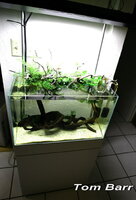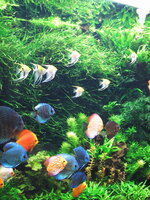Given your goals and what trade offs you seem more interested in:
The light sounds good.
Non CO2 methods really work very well for long term care, but then your fish need to be fed and they can be messy, so there's less room for error with food/nutrient balancing.
There's a few ways to do this to make that part easier: more floating plants and an open top design. The plants will scrub the water clean, you'll need to add more nutrients, likely K+ and traces, and perhaps a little NO3.
I keep L046 zebras in a non CO2 tank, do weekly 50-60% water changes, they are not needed however, I do them mostly so I can stuff the fish to the gills, and I have a large pack of RCS that eat the left overs.

This way you can still see the fish hanging out under the mats of plants.
There's no algae, and no need for CO2.
If you need to do a water change, you can, if not, that's okay as well.
That's but one option.
Another is a pure non CO2 method, using no water changes at all.
A Worm castings, or ADA AS sediment would be wise also, but pure plain old sand works, and you dose 2-4x a month, about 1/2 the dose volume folks use on these higher tech CO2 enriched tanks.
It's not hard, the sediments provide a long term nutrient back up supply also.
Here's a plain sand done using the water dosing method without water changes for about 2 years:

Not bad, but you will not be able to over load this tank and do water changes to rectify the problem.
Those are two options and you can blend them certainly, more % floaters make the CO2 issues go away and greatly increases the rates of nutrient uptake and removal(about 10-20X more so).
So it's best to error on the lower side of nutrient loads from the fish, then top off with a little bit of KNO3 etc here and there.
A 3rd option, and I want you to truly consider this not based on fear because you are unfamiliar with CO2 gas, but look at it as a good tool. Do not let the lack of understanding or experience with CO2 sway you. I am highly supportive of the non CO2 methods if that is the goal and the trades match up.
I think you might want to reconsider CO2 based on your comments.
It's not hard to use with the light system you have.
Low light is ideal for CO2 gas enrichment.
CO2 maximizes the little light you have, so the plants spend more resources gathering every last bit of light rather than stressing to get the CO2. You will have about 3-4X the growth, so it will still be slow growth, but it will allow you to grow any species and have it look very nice. So it's slow but managed growth and it also allows maximal light use efficiency. Basically you get every bit of energy used by plants that way, rather than wasting 50-90% of it since the plant has to nab the low levels of CO2 aggressively.
So you get much more out what little light you have.
The fish are fine either way, particularly so and much easier since light drives CO2 demand. With low light, there's a lot of wiggle room in dosing the CO2. Fish do very well, breed etc even at 45ppm of CO2, and warm temps in the 30C-31C ranges in planted tanks.
A 1000 liter tank is a large piece of indoor real estate, I think it should be done right so you really enjoy it and it must look nice, other wise the significant other will harp. So the CO2 sounds like a good idea to consider.
I'm not telling you to add more light, please note that. Just CO2.
I came to these conclusion decades ago for myself and more most folk's goal, but few listen to lower light in the USA.
Cost of energy is a concern these days, so some are reconsidering it, and algae issues etc also seem to go away very easily and never come back once they see the (low) light.
So it's not the terrible thing you may have read about, the evil lurking under the cabinet
😀
I would suggest using a nutrient rich sediment if possible, DIY for saving $ or ADA AS.
If you want a white sand, then the worm castings might work better for you and topped with the sand of your choice, or I just go plain dolomite sand here:

This is a 350 gal, 400 gallon total volume.
This tank uses CO2, but it fairly low light.
Same thing for this next tank, which is 1600 Gallons, the angels are F1's that have never been out of this aquarium, and discus have breed many times now in this tank as well as the cories.

The white sand front with Driftwood and epiphytes works well for the discus along with low light T5's(Gieseman bulbs have a nice look for plants and the fish). Plants are easy to keep, fish are comfy, you can feed well, they have places to pick at the food etc, easy to clean etc.
Water changes can be done like this: 20% 2x a week or 40%. You can add what warmer water you have.........then the cold water is fine, as long as the filters and heaters are running as well. A 7-8 C drop is fine.
The heaters will bring it up in about 1-2 hours later.
I would suggest hard plumbing this tank to the house water for hot/cold and having a drain hard plumbed as well.
This is well worht the cost or if you can DIY, go that route. This way all you do is a turn of a valve to drain it to 40%, then turn another to refill it. 400 liters should not break the hot water volume at your home if you have a typical water heater, mine is about that range, but it refills and heats back up pretty quick.
Do not do the water change after showers or during laundry day.
You can also do the slow refill method and work on the tank, prep foods, wipe glass, , check and clean things for 1-2 hours each water change.
A pre carbon filter where this comes in from the house water line is wise also, removes organics and chlorine.
The short term cost for the CO2, sediment and hard plumbing might seem tough.
I can assure you, over time, it more than will pay for itself.
I remove about 100$ worth of ferns monthly and they are bought in less than 24 hours on line for full asking price in the 350 Gallon tank. So the CO2 helps and pays for itself pretty quick.
The reduced labor and chore, less motivation required when all you do is a valve turn make the water changes cleaner around the home/less mess, and far easier, thus more likely that you will do them. So there's a few things to consider. It's a big project.
Regards,
Tom Barr







